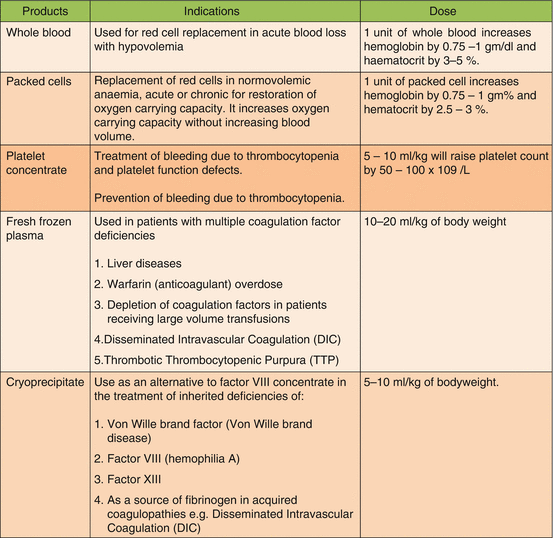Fig. 24.1
Primary hemostasis, secondary hemostasis and the fibrinolytic pathway. FDP – fibrin degradation products
Table 24.1
Causes of bleeding disorders

Management of Haemorrhage
In treating the acutely bleeding patient, management should focus on early recognition of blood loss, rapid control of the source of bleeding and restoration of circulating blood volume. Emergency intervention to stop the source of blood loss as soon as possible (e.g. surgery) is of paramount importance for a good outcome. Meanwhile, blood, blood products, drugs and volume replacement can be administered as required to support the circulation.
Adequate blood pressure, circulatory volume and hemoglobin are necessary to enable oxygen to be delivered to the tissues. Prolonged hypotension or shock resulting from blood loss can become irreversible, due to tissue hypoxia and acidosis. Besides management of volume and oxygen delivery, the hemostatic component of blood has to be corrected as well to maintain the circulation, once the source of bleeding has been stopped. The blood components that can be used to restore the coagulation profile, oxygen carrying capacity and circulatory volume are as listed in Table 24.2.

Table 24.2
Blood components that can be used to restore the circulation

Colloids and crystalloids can be used to restore the circulation, provided the level of hemoglobin in the patient’s circulation is sufficient for oxygen delivery. These colloids and crystalloids are discussed in Chap. 29. Blood products such as platelets, fresh frozen plasma (FFP) and cryoprecipitate should not be used as volume replacement. Instead their use should be targeted to replace the deficient components. The decision as to which blood component needs to be administered can be guided by point of care testing such as Thromboelastography (TEG) or plasma based coagulation tests (PBCT).
Monitoring of Coagulation Disorders
Thromboelastography Versus Plasma Based Coagulation Tests
Thromboelastography (TEG) has been shown to provide faster results in comparison to the plasma based coagulation tests such as the platelet count, prothrombin time, fibrinogen, antithrombin and D-dimer. TEG provides rapid information about hemostatic changes in the presence of significant blood loss and can provide valuable indications for specific blood product therapy. This is advantageous in the setting of on-going hemorrhage. However, laboratory analysis of plasma based coagulation tests such as fibrinogen and antithrombin provide better information about the specific factors that cause impaired hemostasis. Fibrinogen has been shown to be the most important factor in controlling bleeding and is the first factor to decrease to critical levels in massive bleeding.
Hemostatic Resuscitation
Recently, the concept of hemostatic resuscitation has been introduced. Early pre-emptive balanced transfusion therapy is advocated. The blood and blood products are recommended to be given in a fixed red blood cells (RBC): FFP: Platelet ratio of 1:1:1 in the early stage of massive bleeding. As bleeding is a dynamic process, the transfusion therapy can then be goal directed according to the point of care test of TEG or the PBCTs.
Hemostatic Drugs
Hemostatic drugs are agents that have been shown to reduce the need for blood products. The various products work at different sites in the coagulation pathway and the fibrinolytic pathway.
Stay updated, free articles. Join our Telegram channel

Full access? Get Clinical Tree


